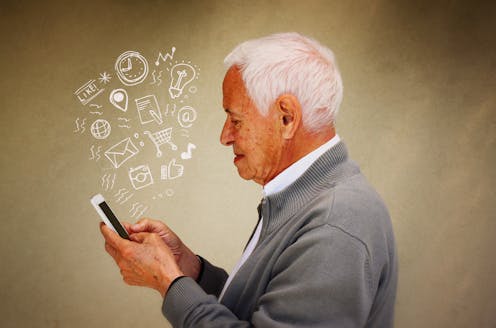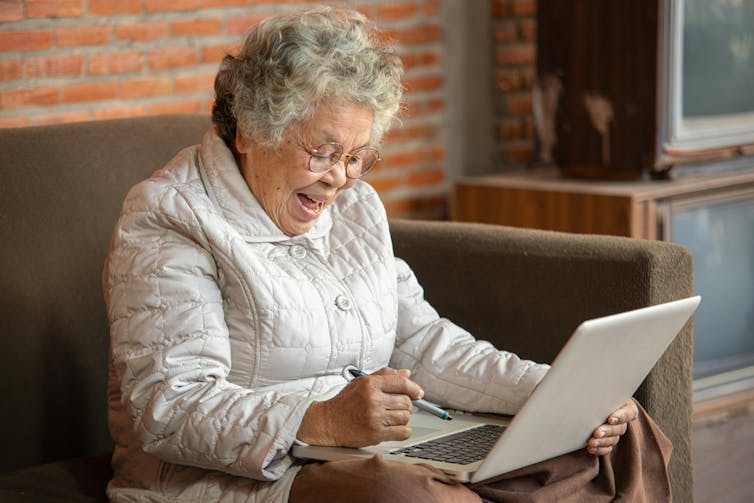
It’s a well-worn stereotype: the image of an elderly person fiddling with technology that leaves them completely bamboozled. The media often depict older people struggling to use or manage digital technology. While this is often designed to be humorous, it can undermine them as users of technology. And that’s a problem if it turns older people off from trying to engage with digital devices, as it can affect their wellbeing.
Older adults are already at a digital disadvantage: 18% of over-65s do not have internet access. Propelled by enforced isolation, older people increasingly turned to technology during the pandemic, but not all were able to connect or communicate with friends and family via the internet.
Of course some older people have less experience of digital technology than others, and unsurprisingly describe mixed emotions regarding the use of everyday devices such as smartphones, laptops, e-readers and tablets. They also report not having much confidence when it comes to using them. Lack of control, a sense of being overwhelmed, and poor product design can lead to feelings of being incompetent, alone and even trapped.
Yet for those who persevere, the rewards can be plentiful: completing tasks more easily, communicating more effectively, increased independence and a sense of achievement. These things are important if this growing part of the population is to experience ageing in a more positive and empowering way.
Through our research we wanted to examine these mixed emotions that older people have about using technology, and how they develop ways to combat the challenges they face. While digital technology has been shown to alleviate pressure on health and social care, until now there’s been a limited understanding of how using technology influences the way older adults live.
Attitudes towards technology
While many see digital technology as a challenge to be conquered, there are different ways of overcoming or confronting the obstacles. Some may view the challenge as a personal goal, using instruction manuals or simply trial and error to prevail over software updates, unwanted viruses or junk mail.
Others view digital technology as a collective endeavour, asking friends and family for help. Not only is this the most successful strategy, it also fosters important interaction with others. For example, during the pandemic many younger people acted as IT support for older friends and relatives.
Not all elderly people have this kind of network, but arguably they can benefit most from greater use of the internet to feel connected and keep loneliness at bay. In these situations, there are useful schemes run by charities such as Age UK, where digital champions can help older adults master technology.
Adopting strategies
Understandably frustrations emerge when learning a new skill, but some older people have shown how they overcome their exasperation by developing a relationship with their devices. Naming their tablet or humanising their phone helps to bond older people to technology.
In our study different devices were often referred to as having a personality, gender, or even a mind of their own. This strategy brings a little levity to a situation that could otherwise be stressful.
Once these people become more used to digital technology, familiarity can encourage continued use. With a new device, software and apps they know and understand can be downloaded so that it feels less alien. Similarly, if a touchscreen is problematic, some older people might decide to use a keyboard and mouse instead.

Breeding confidence
Using technology at any age can have its pros and its cons, but our research reveals that older adults can offer a unique perspective. Using lifelong wisdom, they can take a step back and acknowledge that technology has its faults. If things go wrong, their judgement and experience is useful in helping to understand that the key to using technology is persistence. One participant, Christopher, 83, said:
There’s one sure thing: life will come to an end, and technology will always go wrong. My son’s partner sends me texts from their holiday in Tunis. When I try to reply I keep getting ‘no service’ and my message is refused … [but] I know they will be worried if they don’t get a reply. When I was a kid, Tunis was a distant desert war zone, with cinema newsreels a week later … and here’s me now, whingeing about lack of instant contact.
These findings are significant for technology development, marketing and customer services. Designing technology for older people should be based on their experiences and offer continuity. Digital devices need to include familiar commands, buttons, screens, and add-ons to previous models. This will enhance the ability to get to grips with updates and developments. And in turn this will help foster social connections as well as boost independence and confidence.
Stereotyping of older people also needs to stop. Experience and perspective should be acknowledged, respected and reflected in marketing campaigns. Messaging should underscore the potential benefits of mastering technology, emphasising the importance of being connected and socially involved to a person’s independence.
Finally, customer service should be easily accessible and well versed in issues older people face to provide the necessary support, building on schemes offered by Age UK’s digital champions. Clearly there is a crucial role for friends, family, and communities to ensure that older people remain socially active, engaged and connected through technology. Their wellbeing may depend on it.
The authors do not work for, consult, own shares in or receive funding from any company or organization that would benefit from this article, and have disclosed no relevant affiliations beyond their academic appointment.
* This article was originally published at The Conversation

0 Comments